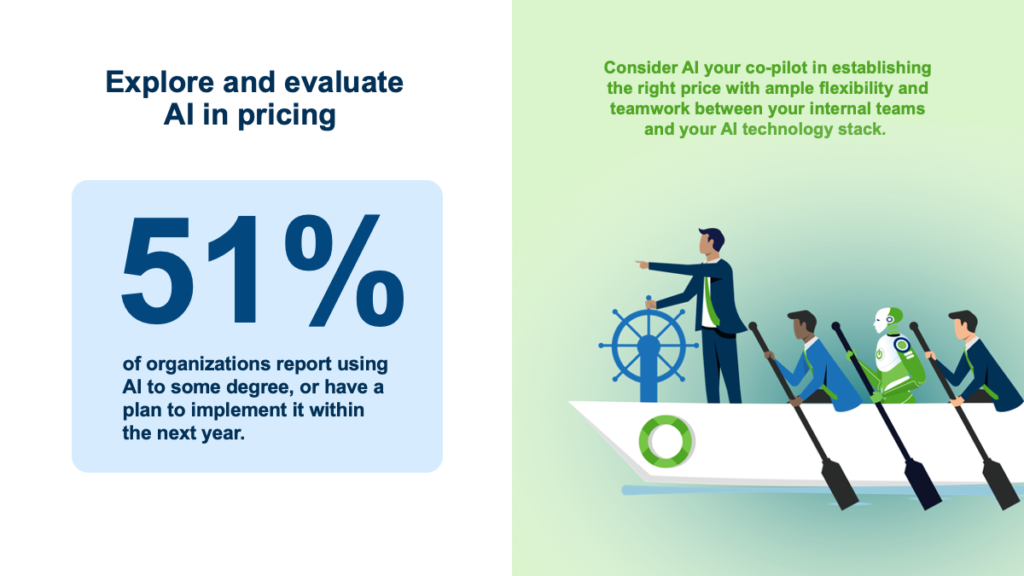Your passion for distribution pricing is what fuels our mission to deliver the most valuable and actionable insights to your inbox.

What’s Really Driving the Pricing Evolution in Distribution?
Pricing is the battleground where wholesale distributors compete for profitability and market share. More distributors are realizing that pricing is not a simple decision to be made during a sales negotiation nor a financial consideration run by number crunchers.
Pricing is strategic. It fuels new growth, especially considering the recent inflation, economic turbulence and supply chain disruptions we’ve experienced over the last several years. These forces are driving changes in the distribution industry as a whole, but are even more disruptive when it comes to how distributors price.
Pricing in distribution is undergoing yet another moment of evolution. Strategic leaders in the industry can take advantage of emerging trends and technology to stay ahead.
#1 Persisting Pricing Pressure
Inflation puts a heightened pressure on pricing. In distribution, it can be difficult to react to spiraling costs when you already have inventory committed, which is a major reason why the industry is hyper-sensitive to inflation. While overall inflation seems to be cooling, the recent volatility in prices, logistics costs and many other ripple effects throughout the supply chain have made price setting more complex than just calculating a simple cost-plus margin. Inflation has changed more than just replacement costs. It has forced many distributors to look not only at costs, but at pricing strategies to drive higher margins.
Even as inflation cools, pricing pressures persist. It is no longer sustainable to simply maintain your current pricing models. If you want to stay healthy and competitive in distribution, you need to deeply understand cost structures and customer patterns.
#2 The Widening Sphere of Pricing Influence
One interesting trend we’re seeing in the distribution industry is that as pricing becomes more visible, more people are getting involved in pricing decisions. This is particularly true with sales and marketing teams who have become more collaborative with pricing managers. In Vendavo’s recent Pricing Excellence Report, we found that 54% of organizations say pricing authority has moved to sales and marketing teams. Ownership has moved away from the business line since 2020.

This signifies a fairly large change in the decision-making dynamics within distribution companies that is driven by access to more sophisticated data analytics tools. Sales and marketing teams that once relied on anecdotes and intuition now have access to data that can predict customer and market trends. When you combine that data with their proximity to field sales and customer interactions, sales and marketing teams can bring a unique understanding of their customers’ perception of value. Value is the biggest driver of competitive advantage in distribution and allows a company to set more favorable pricing.
Mitch Lee, VP of Product Marketing at Vendavo said, “Sales and marketing teams are very close to customer expectations so shifting pricing responsibilities to them is good, but could also be a double-edged sword if the organization isn’t careful with goal-setting. If your sales and marketing team is focused only on more deals, that could come at the expense of company profitability.”
For distribution companies to leverage this trend in expanding pricing data and decisions, they need to invest in the right analytics and training for their entire team. With the right resources, more people can bring expertise to pricing decisions which means more agility when responding to changing markets and competition.
#3 Pricing Teams are Still Small
Vendavo’s report also revealed that the size of traditional pricing teams hasn’t dramatically changed. Most pricing teams are between 1 to 5 people, according to the research.

Distributors who have implemented sophisticated pricing solutions like Vendavo Pricepoint, are seeing an increase in overall effectiveness without needing to increase the size of their teams. That makes these new pricing strategies even more profitable.
The relatively stable team composition over the past few years indivates that organizations feel more confident in their pricing practices and could suggest that companies have found an optimal team size that meets their pricing needs.
#4 AI and Emerging Technologies are Making Pricers More Efficient
More than half of organizations are either already leveraging AI for pricing or planning to do so within the coming year. This trend underscores a movement towards smarter pricing strategies that use technology to our advantage.
The goal here isn’t to phase out humans, it’s to empower them. AI is stepping in to take care of the repetitive grunt work, which means our pricing experts can focus on the big-picture, strategic work that adds real value.
At Vendavo, we’re tuned into this shift. We’ve designed our AI solutions to complement the skills of pricers, giving them tools to oversee and refine the tech as needed. It’s about harmony between the number crunching of machines and the strategic thinking of humans. Our solutions are purpose-built, not just for the sake of innovation but to genuinely drive profitability. They’re at their best when helping inform crucial decisions—like what to offer, at what price, and to whom. It’s all about enhancing the customer experience, ensuring that every interaction feels personalized and spot-on.

Greater Understanding of Value Perception
One argument among distributors who have not embraced new pricing technologies is that a product is only worth as much as a customer is willing to pay for it. So why should we analyze pricing? The truth is that distribution is a very complex business and customers pay for much more than just single items. Value-added services drive perceptions of value for your entire offering and can lead to higher pricing. But you must be able to include your cost structure into your pricing considerations to make sure your value-adds are in line with profitability.
You need to go beyond just product features and brand value and look at your entire value proposition, including things like customer service, training, support, shipping and delivery options and overall experience. Distributors who can better communicate this value and deliver on these services can enjoy better pricing and higher margins, even during volatile economic conditions.
Understanding your pricing dynamics based on your actual data allows you to invest in programs that create new and profitable value-added services. This can free your sales team to focus on value-based selling and align their efforts to your overall business strategy.
The Future of Pricing
One thing is clear, and that is that technology is helping to shift the role of the distribution pricing professional. Technology automates repetitive tasks for faster and more accurate pricing decisions. More importantly, as distributors elevate the role of pricing in their organizations, they are also rewarding strategic thinking and business acumen. The more you can understand about your market, the more value you can drive to the bottom line. Data is critical, but so are different customer-centered viewpoints.
Distributors who continue to reward innovation and strategic thinking will help to future-proof their pricing teams for greater profitability and margin protection. Technology also levels the playing field, so as pricing increases in focus for more distributors, you must be nimble, adaptive and willing to challenge the conventional wisdom in your markets to make bold pricing decisions. Pricing is never a static process – it is always evolving. Distributors who invest in the right people, technology and strategies can thrive even in uncertain conditions.




